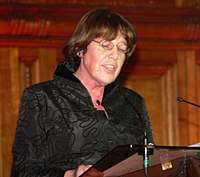Catherine Bréchignac
Catherine Bréchignac (French pronunciation: [katʁin bʁeʃiɲak] (![]()
Catherine Bréchignac | |
|---|---|
 Catherine Bréchignac in 2006 | |
| Born | 12 June 1946 |
| Nationality | French |
| Alma mater | École Normale Supérieure de Lyon Faculté des sciences d'Orsay |
| Awards | Commander of the Légion d'honneur Many others, see article |
| Scientific career | |
| Fields | Physics |
| Institutions | CNRS |
Biography
Daughter of the physicist Jean Teillac and alumnus of the École Normale Supérieure de Fontenay-aux-Roses, Catherine Bréchignac received her DEA (Masters-level qualification) at the Faculté des sciences d'Orsay in 1971, her doctorate in 1977, and became a Research Director in 1985. In 1989 she became director of the Aimé Cotton laboratory, and was Director General of the CNRS from 1997 to 2000. She clashed with Claude Allègre, the minister at the time, over reforms she oversaw at the institution.[3] She became President of the Institut d'optique théorique et appliquée ("Institute of Optical Theory and Practice") in 2003 and of the Palais de la découverte ("Palace of Discovery") in 2004. In 2005 she was elected future president of the International Council for Science (ICSU).[4] She was appointed President of the CNRS at the Council of Ministers of 11 January 2006 on the recommendation of François Goulard, the minister for higher education and research.[5][6] She was replaced by Alain Fuchs in 2010, even though she was a candidate to her own succession.[7] She was "secrétaire perpétuel" (permanent secretary) of the Académie des sciences, Division 1,[8] from 2011 to 2018.[9]
Field
According to the International Council for Science, Bréchignac co-founded the field of cluster physics, which straddles the gap between atomic, molecular and solid-state physics.[4] Clusters are "the precursors of nano-objects."[4]
Other functions and honours
|
|
References
| Wikiquote has quotations related to: Catherine Bréchignac |
- Terraso, David (2006-02-13). "Professor named president of Europe's largest scientific body". Georgia Institute of Technology. Archived from the original on 2011-07-19. Retrieved 2009-05-29.
- "At the centre of revolution in research: Catherine Bréchignac". Times Higher Education. 2000-04-14. Retrieved 2009-05-29.
- "Catherine Bréchignac". Les Échos (in French). 2008-06-18. Archived from the original on 2012-09-05. Retrieved 2009-05-29.
- "Executive Board - ICSU President: Catherine Bréchignac". International Council for Science. 2009-06-02. Archived from the original on 2009-06-15. Retrieved 2009-05-29. ICSU]
- "New president pledges to put science back at the top of CNRS agenda". Times Higher Education. 2006-02-09. Retrieved 2009-05-29.
- Blandin, Noël (2006-01-12). "Catherine Bréchignac est nommée présidente du CNRS". République des Lettres (in French). Retrieved 2009-05-29.
- Jacqué, Philippe (14 January 2010). "Un nouveau patron à la tête du CNRS". Le Monde (in French).
- Contact us, Académie des sciences, retrieved 9 November 2015
- "Communiqué de presse : Étienne Ghys élu Secrétaire perpétuel de l'Académie des sciences" (in French). Académie des sciences. 19 July 2018. Retrieved 4 February 2019.
- Décret du 18 avril 2014 portant promotion, Journal officiel de la République française, n°0094, 20 April 2014, p. 6950